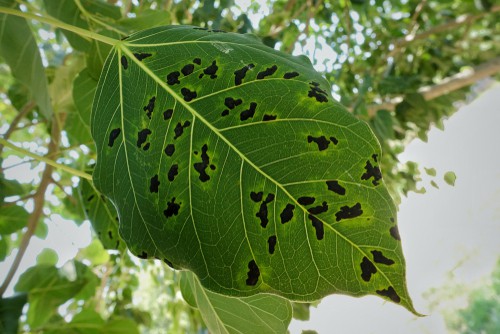Black spots on fig tree leaves are a common problem that can affect the health and appearance of your fig tree.
These spots can be caused by a variety of factors, including fungal diseases, insect damage, and environmental stressors. Identifying the cause of black spots on your fig tree leaves is important in order to effectively treat the problem and prevent further damage.
Understanding fig tree leaves is an important first step in identifying black spots and other issues. Fig leaves are typically large, lobed, and dark green in color. They can be susceptible to a variety of diseases and pests, which can cause discoloration, wilting, and other symptoms.
Identifying the specific symptoms and patterns of damage on your fig tree leaves can help you determine the cause of the problem.
Common diseases causing black spots on fig tree leaves include anthracnose, leaf spot, and fig rust. These diseases are typically caused by fungal spores that thrive in warm, humid conditions. Insects such as mites and scale can also cause damage to fig tree leaves, which can lead to the development of black spots.
Environmental factors such as drought, excessive moisture, and poor soil quality can also contribute to the development of black spots on fig tree leaves.
Key Takeaways
- Understanding fig tree leaves is important in identifying black spots and other issues
- Common diseases causing black spots on fig tree leaves include anthracnose, leaf spot, and fig rust
- Effective treatment of black spots on fig tree leaves requires identifying the underlying cause and implementing appropriate control measures
You will also like these other top posts in this category:
Understanding Fig Tree Leaves
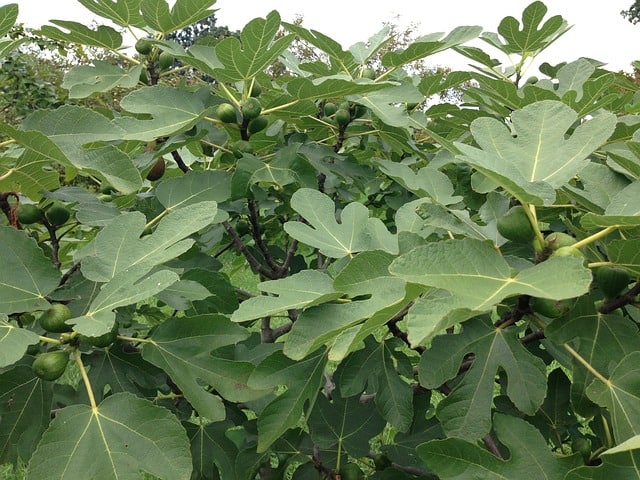
Fig tree leaves are an essential part of the tree’s overall health. They play a vital role in photosynthesis, a process that converts sunlight, carbon dioxide, and water into energy and oxygen. Healthy fig tree leaves are green, glossy, and free of any spots, blemishes, or discoloration.
When fig tree leaves start to develop black spots, it is usually a sign of a problem. Black spots on fig tree leaves can be caused by various factors, including fungal diseases, insect infestations, overwatering, and poor soil conditions.
Fungal diseases are one of the most common causes of black spots on fig tree leaves. The most common fungal diseases that affect fig trees include anthracnose, fig rust, and leaf spot. Anthracnose is a fungal disease that causes dark, fluid-soaked spots on the leaves that get larger and turn brown or black.
Fig rust, on the other hand, causes yellow spots on the underside of leaves, which turn into black spots as the disease progresses. Leaf spot is another fungal disease that causes black spots on fig tree leaves. It is very similar to anthracnose and easily confused.
Insect infestations can also cause black spots on fig tree leaves. The most common insects that affect fig trees include mites, scale insects, and thrips. These insects feed on the sap of the leaves, which can cause discoloration, spots, and blemishes.
Overwatering and poor soil conditions can also cause black spots on fig tree leaves. When fig trees are overwatered, the roots can become waterlogged, which can lead to root rot. Poor soil conditions can also cause nutrient deficiencies, which can affect the health of the leaves.
Identifying Black Spots on Fig Tree Leaves
Fig trees are a popular fruit tree that can produce a delicious and nutritious crop. However, they are susceptible to various diseases, including black spots on their leaves. This section will discuss how to identify black spots on fig tree leaves.
Black spots on fig tree leaves are a common symptom of several fungal diseases, including fig rust and leaf spot. These diseases can cause significant damage to the tree and reduce fruit production.
The black spots are typically small and circular and can appear on both the upper and lower surfaces of the leaves. In some cases, the spots may merge, forming larger patches.
Fig rust is a fungal disease that typically appears in the fall. The first signs of fig rust are tiny yellow spots on the underside of the leaves. The rust then spreads to the upper portion of the leaf, and the spots become reddish-brown. As the disease progresses, the leaves may turn yellow and drop prematurely.
Leaf spot is another fungal disease that affects fig leaves. The symptoms of leaf spot are similar to those of fig rust, with the exception that the spots may have a yellow halo around them. The spots may also have a dark border and a light center. As the disease progresses, the spots may merge, forming larger patches.
Common Diseases Causing Black Spots
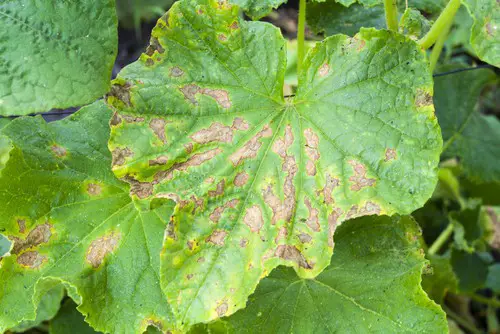
Black spots on fig tree leaves are a common problem that can be caused by various diseases. Here are some of the most common diseases that cause black spots on fig tree leaves:
1. Rust
Rust is a fungal disease that affects the leaves of the fig tree. It is characterized by small, orange to brown spots on the leaves that eventually turn black. The spots are caused by spores that are produced by the fungus and spread by wind and water.
Rust can be prevented by keeping the leaves dry and avoiding overhead watering. If rust is already present, remove the infected leaves and spray the tree with a fungicide.
2. Fig Rust
Fig rust is a type of rust that specifically affects fig trees. It is caused by the fungus Cerotelium fici and is characterized by small, yellowish-orange spots on the leaves that eventually turn black.
Fig rust can be prevented by keeping the leaves dry and avoiding overhead watering. If fig rust is already present, remove the infected leaves and spray the tree with a fungicide.
3. Leaf Blight
Leaf blight is a fungal disease that affects the leaves of the fig tree. It is characterized by small, circular, water-soaked spots on the leaves that eventually turn black. The spots can grow and merge, causing the leaves to wither and die.
Leaf blight can be prevented by keeping the leaves dry and avoiding overhead watering. If leaf blight is already present, remove the infected leaves and spray the tree with a fungicide.
4. Fig Mosaic
Fig mosaic is a viral disease that affects the leaves of the fig tree. It is characterized by yellow or green mottling on the leaves that eventually turns black. The disease can also cause stunted growth and reduced fruit production.
Fig mosaic is spread by insects, so controlling insect populations can help prevent the disease. There is no cure for fig mosaic, so infected trees should be removed and destroyed.
5. Fungal Diseases
Various fungal diseases can cause black spots on fig tree leaves. These diseases include anthracnose, leaf spot, and black spot. They are characterized by small, circular spots on the leaves that eventually turn black.
Fungal diseases can be prevented by keeping the leaves dry and avoiding overhead watering. If fungal diseases are already present, remove the infected leaves and spray the tree with a fungicide.
Role of Insects in Leaf Damage
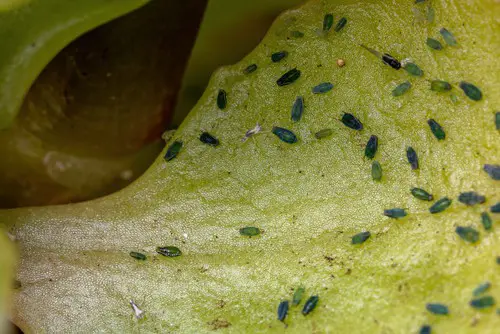
Insects are one of the main causes of leaf damage in fig trees. An infestation of insects can cause black spots on fig tree leaves. Aphids are one of the most common insect pests that infest fig trees. These tiny insects suck the sap from the leaves, causing them to wilt and turn yellow.
Another insect pest that can cause black spots on fig tree leaves is the dried fruit beetle. These beetles feed on the fruit of the fig tree and can cause significant damage to the leaves as well. Dried fruit beetles are attracted to ripe or overripe fruit, so it is important to harvest figs as soon as they are ripe to avoid attracting these pests.
Insects can also spread fungal diseases that can cause black spots on fig tree leaves. For example, the fig rust fungus is spread by an insect called the fig wasp. This fungus can cause black spots on the leaves, as well as yellowing and premature leaf drop.
Preventing insect infestations is an important part of fig tree care. Regularly inspecting the tree for signs of insect pests and treating any infestations promptly can help prevent damage to the leaves.
Insecticidal soaps and oils can be effective in controlling many insect pests, but it is important to follow the manufacturer’s instructions carefully to avoid damaging the tree or harming beneficial insects.
Impact of Environmental Factors
Environmental factors play a significant role in the development and severity of black spots on fig tree leaves. Here are some of the factors that can impact the health of a fig tree and increase the likelihood of black spots:
1. Soil Type and pH
Fig trees grow best in well-draining soil with a pH between 6.0 and 6.5. If the soil is too acidic or alkaline, it can affect the tree’s ability to absorb nutrients and water, leading to stress and an increased risk of disease. Soil pH can be adjusted by adding lime or sulfur, depending on whether the soil is too acidic or alkaline.
2. Stress
Stress can weaken a fig tree’s immune system and make it more susceptible to disease. Stress can be caused by a variety of factors, including drought, overwatering, poor soil quality, and extreme temperatures. It is important to identify and address the underlying cause of stress to prevent further damage to the tree.
3. Lack of Water
A lack of water can cause fig trees to become stressed and more vulnerable to disease. During the spring and dormant seasons, it is important to ensure that the tree receives enough water to stay healthy. However, overwatering can also be detrimental to the tree’s health, so it is important to find the right balance.
4. Spring
Spring is a critical time for fig trees, as it is when new growth and fruit production occur. During this time, it is important to monitor the tree for signs of disease and address any issues promptly. Regular pruning and fertilization can also help promote healthy growth and reduce the risk of disease.
Nutrient Requirements and Deficiency
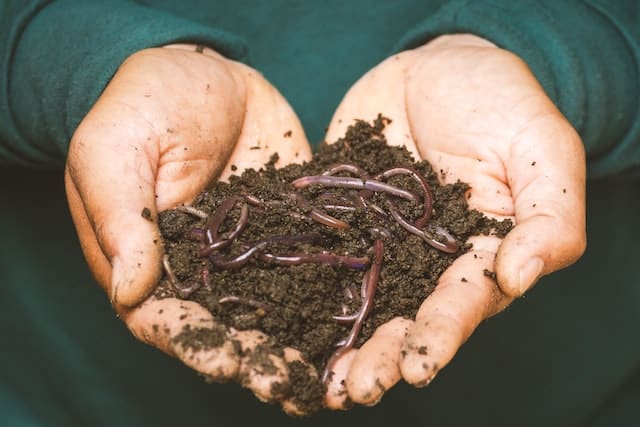
Fig trees require a balanced supply of essential nutrients to grow and produce healthy leaves and fruits. Nitrogen (N), phosphorus (P), and potassium (K) are the primary macronutrients that fig trees need in large amounts.
Nitrogen is essential for leaf growth and chlorophyll production, while phosphorus is necessary for root development and fruit production. Potassium is essential for overall plant growth and helps regulate water balance.
A lack of nutrients can cause visible deficiency symptoms in fig tree leaves. For example, a nitrogen deficiency can cause yellowing of leaves, stunted growth, and reduced fruit production. A phosphorus deficiency can cause dark green leaves, purple veins, and reduced fruit production.
A potassium deficiency can cause yellowing or browning of leaf edges, weak stems, and reduced fruit production.
To prevent nutrient deficiencies, it is essential to provide fig trees with a balanced fertilizer. A balanced fertilizer contains a mix of macronutrients and micronutrients, including N, P, and K.
It is best to apply fertilizer in early spring before new growth begins and again in mid-summer after fruit production. Over-fertilization can also cause problems, so it is essential to follow the manufacturer’s instructions and not exceed the recommended dosage.
In addition to providing balanced fertilizer, it is also crucial to maintain proper soil pH levels. Fig trees prefer a slightly acidic soil pH of 6.0 to 6.5. If the soil pH is too high or too low, nutrient availability can be affected, leading to deficiency symptoms. A soil test can help determine the soil pH and nutrient levels, allowing for proper adjustments to be made.
Effective Watering Techniques
Watering is an essential aspect of fig tree care. Proper watering techniques ensure that the tree receives adequate moisture to maintain optimal health and growth.
Overwatering or underwatering can lead to stress on the tree, which can result in black spots on the leaves. Here are some effective watering techniques that can help prevent black spots on fig tree leaves:
1. Check the Soil Moisture
Before watering, it is important to check the soil moisture level. The best way to do this is to stick your finger into the soil about an inch deep. If the soil feels dry at this depth, it is time to water the tree. If the soil feels moist, wait a day or two before checking again.
2. Water Deeply and Infrequently

When watering, it is important to water deeply and infrequently. This means watering the tree until the soil is wet to a depth of at least 6 inches. Avoid frequent, shallow watering, as this can lead to water stress and black spots on the leaves.
A good rule of thumb is to water the tree once a week during the growing season and once every two weeks during the dormant season.
3. Use a Soaker Hose or Drip Irrigation System
Using a soaker hose or drip irrigation system can help ensure that the water reaches the roots of the tree without wasting water. These systems deliver water directly to the soil, reducing the risk of water stress and black spots on the leaves.
4. Avoid Watering the Leaves
When watering, avoid getting water on the leaves of the tree. Water on the leaves can lead to fungal growth, which can result in black spots on the leaves. Instead, water the base of the tree, allowing the water to soak into the soil.
5. Mulch Around the Base of the Tree
Mulching around the base of the tree can help retain moisture in the soil, reducing the need for frequent watering. This can also help prevent water stress and black spots on the leaves.
Importance of Pruning
Pruning is an essential part of fig tree maintenance and plays a crucial role in preventing black spots on fig tree leaves. Pruning helps to keep the tree manageable by controlling its size and shape. It also promotes healthy growth and encourages fruiting on one-year-old wood.
When a fig tree is not pruned, it can become overgrown, which can lead to a lack of sunlight and airflow. This can cause the leaves to become crowded, which can create a humid environment that is conducive to fungal growth.
Fungal diseases, such as fig rust, can cause black spots on fig tree leaves, which can eventually lead to leaf drop and affect the overall health of the tree.
Pruning can help to prevent fungal growth by allowing sunlight and airflow to penetrate the tree canopy. It also helps to remove dead or diseased wood, which can harbor fungal spores. By removing this wood, pruning can prevent the spread of fungal diseases and promote healthy growth.
It is important to prune fig trees during the dormant season, which is typically in late winter or early spring. Pruning during this time can help to prevent excessive sap loss and promote new growth. It is also important to use sharp and clean pruning tools to prevent the spread of disease.
Chemical Control Methods
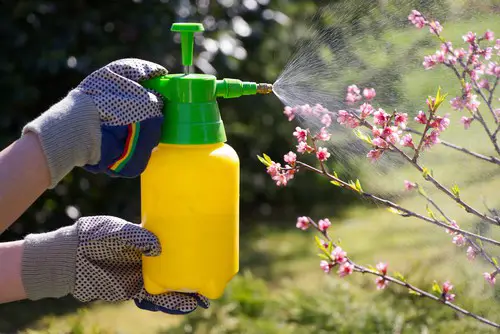
Chemical control methods are a common way to manage black spots on fig tree leaves. Fungicides are the most commonly used chemical control method for black spots on fig tree leaves. Fungicides are designed to kill or prevent the growth of fungi that cause black spots on fig tree leaves.
One fungicide that is commonly used to control black spots on fig tree leaves is copper sulfate. Copper sulfate is a broad-spectrum fungicide that can be used to control a variety of fungal diseases.
It is effective against black spots on fig tree leaves and is relatively inexpensive. Copper sulfate is available in both liquid and powder form and can be applied to fig trees using a sprayer.
Another chemical control method that can be used to manage black spots on fig tree leaves is neem oil. Neem oil is a natural insecticide and fungicide that is derived from the neem tree. It is effective against a variety of fungal diseases, including black spots on fig tree leaves. Neem oil can be applied to fig trees using a sprayer.
It is important to note that chemical control methods should be used as a last resort. Pesticides and fungicides can have negative impacts on the environment and can harm beneficial insects and other organisms. It is important to follow all label instructions when using chemical control methods and to use them only when necessary.
Organic Pest and Disease Control
When it comes to controlling pests and diseases on fig trees, organic methods can be a safe and effective option. Organic pest and disease control involves using natural methods to manage pests and diseases without the use of synthetic chemicals.
One effective organic method for controlling pests on fig trees is the use of horticultural oil. Horticultural oil is a type of oil that is derived from plants and is used to control pests by suffocating them. It is important to note that horticultural oil should only be used during the dormant season, as it can damage foliage if applied when the tree is actively growing.
Another important aspect of organic pest and disease control is sanitation. Keeping the area around the fig tree clean and free of debris can help to prevent the spread of diseases. This includes removing fallen leaves and fruit, as well as pruning out any infected branches.
In addition to horticultural oil and sanitation, there are other organic methods that can be used to control pests and diseases on fig trees. These include the use of beneficial insects, such as ladybugs and lacewings, as well as the use of organic fungicides and insecticides.
It is important to research and carefully select the appropriate organic methods for your specific pest and disease issues.
Understanding Root Knot Nematodes

Root knot nematodes are microscopic roundworms that can cause significant damage to fig trees by feeding on their roots. These nematodes are a common problem for many fruit trees, including figs. They are called “root knot” nematodes because they cause the roots to develop small, swollen knots or galls.
The symptoms of root knot nematode infestation may not be immediately apparent. In the early stages, the infected tree may appear to be healthy. However, as the nematodes continue to feed on the roots, the tree may start to show signs of stress. The leaves may turn yellow or brown, and the tree may produce fewer figs. In severe cases, the tree may die.
Root knot nematodes are difficult to control, but there are some steps that can be taken to reduce their impact. One option is to plant resistant varieties of fig trees. Some fig cultivars, such as ‘Brown Turkey’ and ‘Celeste,’ are less susceptible to root knot nematodes than others.
Another approach is to improve soil health. Root knot nematodes thrive in soil that is compacted, poorly drained, or low in organic matter. By improving soil structure and fertility, it may be possible to reduce the nematode population and limit their damage.
Chemical treatments are also available for controlling root knot nematodes. However, these treatments can be expensive and may have negative impacts on the environment. It is important to carefully consider the potential risks and benefits before using any chemical control measures.
Special Considerations for Fiddle Leaf Fig
Fiddle leaf figs are one of the most popular indoor plants, known for their large, glossy leaves that can grow up to 18 inches long. However, they can be prone to black spots on their leaves, which can be caused by several factors. Here are some special considerations to keep in mind when dealing with black spots on fiddle leaf fig leaves.
1. Watering
Overwatering is one of the most common causes of black spots on fiddle leaf fig leaves. Fiddle leaf figs prefer to be kept on the dry side, so it’s important to allow the soil to dry out between waterings. When watering, be sure to water deeply and allow any excess water to drain away.
2. Humidity
Fiddle leaf figs are native to the tropics, so they prefer a humid environment. Dry air can cause the leaves to brown and curl, which can lead to black spots. To increase humidity, consider using a humidifier or placing a tray of water near the plant.
3. Light

Fiddle leaf figs require bright, indirect light to thrive. If they are not getting enough light, their leaves can become weak and susceptible to black spots. Consider moving your plant to a brighter location, or supplementing with artificial light.
4. Nutrients
Fiddle leaf figs require regular fertilization to stay healthy and prevent black spots. Use a balanced fertilizer every two to four weeks during the growing season, and reduce frequency during the winter months.
5. Pests
Pests such as spider mites and scale can also cause black spots on fiddle leaf fig leaves. Regularly inspect your plant for signs of infestation, and treat promptly with an appropriate insecticide if necessary.
Frequently Asked Questions
How do you treat brown spots on fig leaves?
Brown spots on fig leaves can be caused by a variety of factors, including fungal diseases, improper watering, and insect infestations. To treat brown spots, it’s important to first identify the underlying cause.
If fungal diseases are the problem, using a fungicide can be an effective treatment. For insect infestations, using a pesticide may be necessary. Proper watering and fertilization can also help prevent brown spots from developing on fig leaves.
What causes fig rust?
Fig rust is a fungal disease that affects fig trees. It is caused by the fungus Physopella fici and is characterized by orange or yellow spots on the leaves, which eventually turn brown and fall off.
Fig rust is most common in humid environments, and can be prevented by practicing good sanitation practices, such as removing fallen leaves and debris from around the tree. Fungicides can also be used to treat fig rust.
Why are my fig tree leaves turning brown and curling?
Brown and curling leaves on a fig tree can be caused by a variety of factors, including insect infestations, fungal diseases, and improper watering. Overwatering or underwatering can both lead to brown and curling leaves.
Insect infestations can also cause damage to the leaves, leading to curling and browning. Treating the underlying cause is key to preventing further damage to the tree.
What can I do about white spots on my fig leaves?
White spots on fig leaves can be caused by a variety of factors, including fungal diseases, insect infestations, and sunburn. To treat white spots, it’s important to first identify the underlying cause.
If fungal diseases or insect infestations are the problem, using a fungicide or pesticide can be an effective treatment. To prevent sunburn, provide adequate shade for the tree.
What causes black spots on fig tree branches?
Black spots on fig tree branches can be caused by a variety of factors, including fungal diseases, insect infestations, and physical damage. To treat black spots, it’s important to first identify the underlying cause.
If fungal diseases or insect infestations are the problem, using a fungicide or pesticide can be an effective treatment. Physical damage to the tree should be addressed promptly to prevent further damage.
What are the dark spots on my fig tree leaves?
Dark spots on fig tree leaves can be caused by a variety of factors, including fungal diseases, insect infestations, and physical damage. To treat dark spots, it’s important to first identify the underlying cause.
If fungal diseases or insect infestations are the problem, using a fungicide or pesticide can be an effective treatment. Physical damage to the tree should be addressed promptly to prevent further damage.

Hey, I’m Lisa and I’ve been an avid gardener for over 30 years. I love writing, talking and living in the garden! Feel free to connect with me on my socials below

